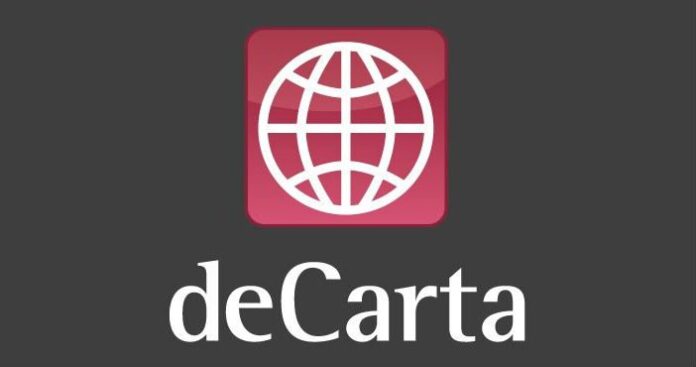Claudia Bacco, Managing Director – EMEA for RCR Wireless News, has spent her entire career in telecom, IT and security. Having experience as an operator, software and hardware vendor and as a well-known industry analyst, she has many opinions on the market. She’ll be sharing those opinions along with ongoing trend analysis for RCR Wireless News.
 DeCarta president and CEO Kim Fennell shares his thoughts regarding the topic of connected cars and the company’s role in this market.
DeCarta president and CEO Kim Fennell shares his thoughts regarding the topic of connected cars and the company’s role in this market.
RCR Wireless News: What is DeCarta’s key industry segment focus?
Kim Fennel: DeCarta is a Silicon Valley-based software company in the location-based services industry. More specifically, we provide the core geospatial platform technology used by LBS application developers, companies and service providers to run their LBS apps and services.
RCRWN: Who are your target customers?
KF: Our platform has applicability in all mobile/Web applications where location services are important ,so we get used in a wide variety of vertical markets including automotive original equipment manufacturers, mobile device manufacturers, mobile operators, fleet management service providers and local search services. Our customers include BlackBerry, Verizon, OnStar, EBay, T-Mobile, Samsung and Inrix for example.
RCRWN: What are the key attributes of DeCarta’s portfolio at a high level?
KF: Over 17 years we have developed the core, scalable geospatial technology that is needed to run LBS apps and services at high volume and on a global scale. This includes mapping, geocoding, local search, routing and navigation apps, and software-developer kits. We do all the difficult geospatial work that makes it easy for developers to build their LBS apps on top of our platform with easy-to-use APIs. We host our customers’ apps or they can self-host them and we provide coverage in over 150 countries including China, Japan and Korea.
RCRWN: You recently announced a partnership with TomTom, can you explain more about the roles of each company and the overall goals of the program?
KF: This is a global distribution agreement whereby TomTom will sell DeCarta technology under the TomTom brand. This partnership is a perfect fit that addresses the needs of both TomTom and DeCarta and ultimately provides customers with a very comprehensive, market competitive LBS solution.
DeCarta has a high-performance LBS platform and cloud-based navigation application, but lacked the size and resources to get to market on a global scale. TomTom has superb map and traffic content and a global sales force and marketing presence, but lacked an LBS platform and cloud-based navigation app. Working together, we can now offer a fully integrated end-to-end LBS technology stack of content, plus platform, plus application across the mobile, GIS, automotive and fleet markets, globally. Together we provide better, more flexible offerings than Google or Nokia/Here.
RCRWN: How would you say your products differentiate from competitors?
KF: The only two companies that really offer a true LBS platform (as opposed to an LBS app) with the full LBS technology stack of mapping, geocoding, local search, routing and navigation and can do it globally are Google and Nokia/Here. (Note: Google actually used DeCarta’s platform for the first four years of Google Maps 2005-2008). Regarding Google, it’s important to distinguish the consumer service from what developers and companies want to use for their own LBS services. For them we offer the same functionality as Google Maps APIs but offer several key advantages:
- More flexibility to customize the app
- More control of the data (customer’s own data)
- Less restrictive license terms (e.g. Google won’t let you use their search results on non-Google maps)
- Differentiated LBS technology such as our patented “search along a route,” which produces search results ahead of drivers on their route as opposed to results behind the driver
- Technology specific to telematics and fleet management such as customizable polygon, geofencing, exclusion zones, etc.
As some validation, we recently replaced Google search with our L2 local search engine at BlackBerry, Verizon and GM OnStar. Compared to Nokia/Here, we offer more country coverage (e.g. China, Japan) and we give customers a wide choice of independent map, points of interest and traffic content (including OSM) to use, whereas with Here you can only use their content. We offer more flexibility to meet the customer’s specific application needs.
RCRWN: What poses the biggest challenge for DeCarta to differentiate?
KF: Size and market presence/awareness. As a small company it’s harder to get to all markets and customers. Plus, we need to be profitable based on our operations in LBS whereas others, such as Google, can subsidize their LBS business from their search business.
RCRWN: How do you work with players in the connected car industry?
KF: We operate in a (business-to-business-to-business) model. We supply to OEMs (e.g. GM OnStar) but mostly through tier-ones and other third parties (e.g. Denso, UI Evolution, Cloudcar). We supply the core local search and cloud-based navigation technology needed to make connected services useful to drivers.
RCRWN: DeCarta talks about a “driver-centric” connected car experience. Can you explain what this is and why it is important?
KF: Today, most in-car LBS and navigation is nothing more than replicating a smartphone, which is neither sufficient nor safe in meeting the needs of drivers. A driver-centric connected car experience to DeCarta is about making more helpful driver-oriented, contextually aware services available to drivers – providing the right information and functionality at the tight time, in a seamless manner (not having to open and close multiple apps while driving) resulting in a more helpful and safer experience.
The typical in-car embedded, onboard navigation applications are out of step with the actual needs of drivers. They are expensive and yet inferior in content and capabilities from what’s on a typical mobile phone. The pre-loaded map and POI data is often already a year old at time of sale and it gets further out-of-date quickly. Worse, being nonconnected, it lacks the real-time information and services drivers prefer, such as traffic flow and incidents, parking availability, gas prices and advanced real-time search.
As a result, drivers have increasingly begun to simply use what’s on their smartphones in a cradle or in their hand. Of course that’s not safe, and worse, the apps are not designed for a user moving at 70 mph down the highway. Some auto OEMs have followed with the approach of simply replicating what’s on the smartphone and linking it to the 7-inch infotainment unit in the dashboard. That’s a bit better, but not enough.
The key point is that LBS applications should behave differently if you’re driving to a coffee shop as opposed to sitting inside a coffee shop. There are two very real problems:
- The various apps such as navigation, search, traffic and parking are not integrated and drivers are having to open and close multiple apps to get all that they need.
- It’s not safe to do this while driving
The right solution is to have LBS apps seamlessly integrated, that are context-aware and work for drivers, providing the right information at the right time and making choices for them based on where they are, and where they need to get to – and on their predetermined preferences.
RCRWN: What do you see as the greatest challenge for connected car LBS going forward and how will DeCarta help to solve this?
KF: The auto industry has to move a lot faster to address the LBS needs of drivers or risk losing control of LBS. More specifically the challenges are all about working with OEMs to:
- Act fast enough to deliver unique services and retain control of the user experience and monetization models before they lose the opportunity to Google and Apple (in the same way the telecom operators lost the same opportunity to own/control LBS).
- Understand the complexity behind server-based (cloud-based) navigation and search services. Most are still focused on embedded navigation models of the past.
- Understand how to deliver “services” as opposed to hardware.
- Understand software and fast iteration times.
- Understand how to modify thinking about revenue generation monetization models and costs as a service and not a COGs model.
DeCarta can help and is helping several OEMs by providing competitive LBS technology that tier-ones and OEMs can integrate with their near-term strategies. Furthermore, we know how to run scalable services, so we can be a conduit to new operating models for the OEMs as service providers.
RCRWN: What is the most exciting trend you see in this area of the market?
KF: I find it fascinating that end-users are prepared to adopt these new services at faster and faster rates, and in many cases – such as the auto market – the user is well ahead of the OEMs in their expectations and hunger for LBS services. We are still at the very early stage of the confluence of location-mobile-automotive and social. It’s going to be a fun ride.
Kim Fennell joined DeCarta as president and CEO in 2004, bringing more than 20 years of global experience in the high-tech industry. Prior to DeCarta, he was CEO of Pinnacle Systems where he led the public company through record revenue growth to $330 million and expanded its market reach through several strategic acquisitions. Fennell is a graduate of Queen’s University at Kingston, Ontario, Canada, and the Stanford Executive Program. He is also director on the board of the Silicon Valley Leadership Group Foundation and a charter member of C100.
Like what you read? Follow me on twitter!

